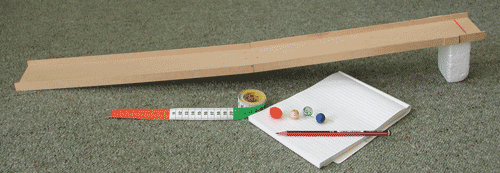| Approach: Team |
Level:
Year 4
and year 8 |
|
| Focus:
Motion and resistance
to motion
|
| Resources:
Wooden
slide, support for high end, glass marble, wooden bead, ball of
plasticine, small pom pom, lump of plasticine, notepaper, pencil,
tape measure, team answer sheet |
 |
824KB |
|
|
| Questions/instructions:
| Preparation:
Set up board on the floor and place objects, tape measure and
note paper in front of it.

In this activity you
will be finding out which of these objects rolls the furthest.
Here are the objects you will be testing.
Hand out answer sheet and pencil. |
|
| |
%
responses |
y4
|
y8 |
Don’t
roll the objects yet, but look at them and discuss which one you think
will roll the furthest. On the answer sheet, write number 1 in the box
beside the object you think will go the furthest. Then write down number
2 for the object that you think will be second, and so on.
Allow time. |
|
|
|
Order: |
|
|
marble,
bead, plasticine, pompom |
77 |
81 |
| marble,
bead, pompom, plasticine |
18 |
17 |
|
Point to the order they have ranked the objects.
|
|
|
1.
Explain the reason why you have put the objects in this order.
|
how
evenly round (spherical) the object is
|
71 |
76 |
how
hard the surface of the object is |
36 |
35 |
how
sticky or non-sticky the surface of the object is |
19 |
26 |
how
heavy the object is |
59 |
80 |
How
well do the reasons given fit the predicted order:
(whether or not the reasons are valid) |
|
|
well |
51 |
66 |
moderately
well |
36 |
26 |
poorly
|
13
|
8 |
| 2.
How could you work out which one rolls the furthest? |
not
marked |
• |
• |
Now
I would like you to talk together in your group to plan a test to find
out which one goes the furthest. Listen to each other’s ideas. You
will need to design your test so that if another group did it the same
way they would get the same answer. Talk together about how you will design
your test, then I’ll ask you to explain your ideas to me.
Allow time. |
|
|
3.
Explain to me how you will do your test.
|
Planning
features: |
|
|
keep
ramp and floor the same |
4 |
29 |
each
object started at same point on ramp |
42
|
72 |
each
object started the same way (released, not pushed)
|
22 |
45 |
| each
object tried at least twice (replication)
|
1 |
18 |
| distance
to finishing point measured in consistent way |
60 |
82 |
results
to be recorded systematically |
26 |
25 |
4.
Now explain to me why you think another group would get the same answer
if they used your test.
|
well
argued |
4 |
27 |
| moderately
well argued |
27 |
39 |
| poorly
argued |
69 |
34 |
Now
you can do your test.
Allow time.
Write your results on the answer sheet. |
Conduct
of experiment: |
|
|
ramp
and floor kept constant |
86 |
96 |
each
object started at same point on ramp |
85 |
98 |
each
object launched same way (released, not pushed)
|
55 |
83 |
each
object tried at least twice (replication)
|
3 |
27 |
distance
to finishing point measured in consistent way |
52 |
87 |
results
systematically recorded |
53 |
81 |
| Now
I would like you to change the shape of this piece of plasticine so that
it doesn’t roll as far as the ball of plasticine but rolls further
than the pom pom. |
|
|
5.
What did you do to the plasticine to make it roll further than the pom
pom but not as far as the first ball of plasticine?
|
made
lump more nearly spherical (or cylindrical)
but less so than plasticine ball |
86
|
91 |
made
into sphere, but added dents or bumps to slow it down |
11
|
15 |
Participation
in team: |
|
|
all
members substantially involved |
80
|
78 |
one
member largely not involved |
18
|
21 |
| two
or more members largely not involved |
2
|
1 |
|
|
|
|
Total
score:
|
18–22
|
0 |
10 |
15–17
|
12 |
39 |
12–14
|
33 |
30 |
9–11
|
33 |
17 |
0–8
|
22 |
4 |
Commentary:
Compared to year 4 teams, year 8 teams were substantially better at thinking
about desirable planning features (except recording). Only three percent
of year 4 teams and 27 percent of year 8 teams used replication to check
and confirm their results. |